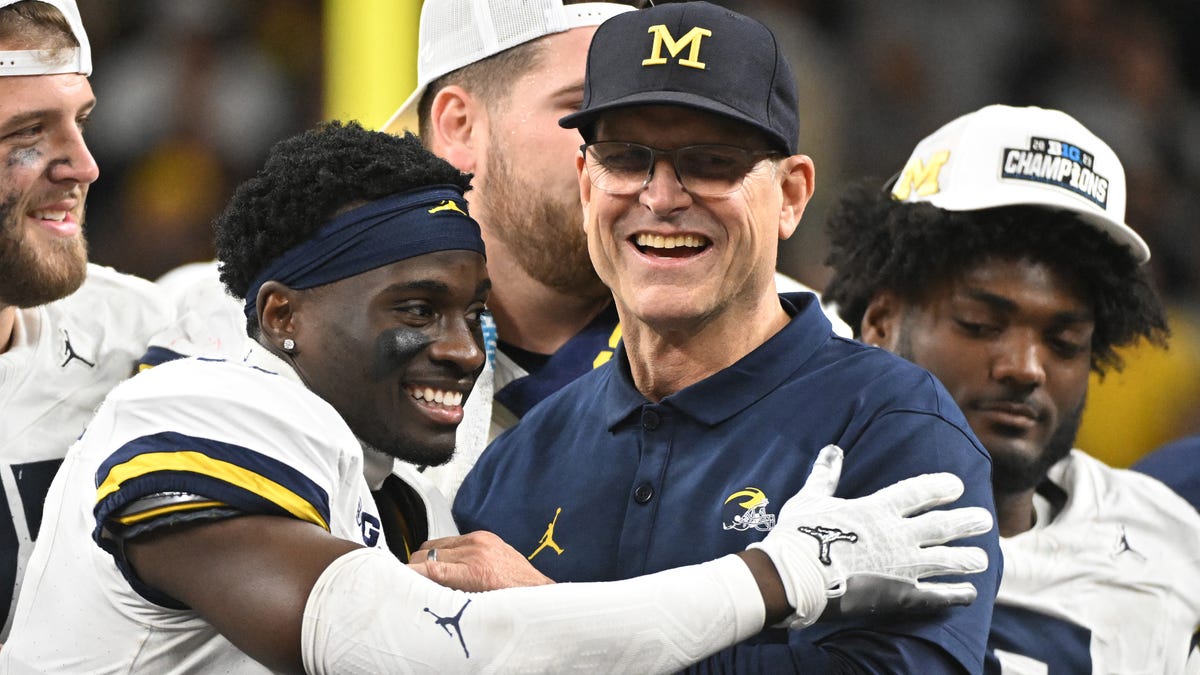Jim Harbaugh leaves Michigan for Chargers head coaching job
Weeks after winning a national title with Michigan, Jim Harbaugh is headed to the NFL where he will occupy the open head coaching job for the Los Angeles Chargers.
Hoisting the College Football Playoff trophy after Michigan’s first outright national championship in 75 years is the most memorable image in Jim Harbaugh’s college coaching career. Mentioning how he can “sit at the big person’s table now” with his championship-winning father and brother, all that was missing from his postgame press conference following the Wolverines’ win against Washington earlier this month was a wall-to-wall “mission accomplished” banner.
As he heads back to the NFL, this indelible moment should end up as his last in the college game.
“That’ll check the biggest box,” he said.
Harbaugh agreed Wednesday to become the next head coach of the Los Angeles Chargers, the team announced.
Achieving what he set out to achieve — bringing a national championship back to Ann Arbor — scratched his itch as a college coach. Given the added possibility of further sanctions because of this season’s sign-stealing scandal and with his stock soaring, this was a predictable moment for Harbaugh to take a second run at the Super Bowl following his earlier stint with the San Francisco 49ers.
After winning big at Stanford and with the Wolverines, the legacy he leaves behind is complicated, unique, underappreciated and destined to land him in the College Football Hall of Fame.
Like Harbaugh himself, and much like the sport at large, his college career was imperfectly perfect.
Harbaugh was suspended for six games during this historic season for two separate violations, the first as a result of NCAA violations that occurred during the COVID-19 season was for the first three games of the season and then a second punishment for the final three games of the regular season was handed down after school’s involvement in a sign-stealing scandal went public and led to the resignation of analyst Connor Stalions. He remade his program and reached new heights in the wake of that year; before then, however, he found his job security on the rocks and his reputation at an all-time low.
Even against that backdrop, Harbaugh’s college career will be remembered most for three separate rebuilding projects, none more impressive than the last, and for being one of the precious few coaches whose arrival would guarantee success.
He arrived at Stanford in 2007 and inherited a one-win team that sat at the bottom of the conference standings. In his first year, he scored one of the biggest upsets in Bowl Subdivision history against Southern California. He had Stanford in the postseason in 2009, and one season later scored a program-record 12 wins and a victory in the Orange Bowl.
There was and is little doubt that Harbaugh had the Cardinal on course to compete for and win a national championship before he became coach of the San Francisco 49ers after that Orange Bowl win. The proof comes in what he left behind: David Shaw replaced Harbaugh in 2011 and went 82-26 over the following eight seasons, expanding upon the foundation left in place to form the greatest run in Stanford’s history. Out of nothing, Harbaugh established the framework for a powerhouse.
Following four seasons in the NFL, Harbaugh was drawn back to a Michigan program in 2015 that had spent seven years in the wilderness, stung by the failed hires of Rich Rodriguez and Brady Hoke.
He won 10 games in each of his first two years, the first Michigan coach to do so in the modern era. In 2016 and 2018, Harbaugh led the Wolverines into Columbus to face rival Ohio State with a chance at playing for the Big Ten championship and a playoff berth but lost both games, in a recurring theme that once threatened to engulf his tenure — heading into 2021, his teams were a combined 3-8 against the Buckeyes and Michigan State.
The low point of the COVID year, which saw the Wolverines lose four of six games, was followed by the greatest three-year run in modern program history. Michigan scored three outright Big Ten championships in a row for the first time ever, beat the Buckeyes three times in a row for the first time since 1995-97, made three playoff appearances in a row and posted three top-five finishes in a row, again a program first in the poll era.
This stretch saw the Wolverines replace Ohio State as the Big Ten’s dominant team, sending the rival into a tailspin of self-reflection, and become the first historic Big Ten program other than the Buckeyes to win an unshared national championship since Minnesota in 1960.
As predicted, Harbaugh’s return to his alma mater brought Michigan to the top of the Big Ten and the FBS. That it took nine seasons to get there isn’t a blight on his résumé but a sign of some sort of midcareer reinvention; Harbaugh changed his coaching staff, his program and himself, dialing back on the “more is more” ethos that defined his first several seasons.
At the time of his departure for Los Angeles, Harbaugh was one of four active FBS head coaches to have won a national championship, joining Clemson’s Dabo Swinney, Georgia’s Kirby Smart and North Carolina’s Mack Brown.
The shelf life of NFL head coaches is even shorter than their college counterparts. Harbaugh collided with ownership and lasted only four years with the 49ers despite owning the second-highest winning percentage in franchise history. Harbaugh, 60, could conceivably win a Super Bowl with the Chargers and have the energy to take another stab at the national championship.
Where would he go? He could possibly return to Michigan, if the opportunity’s there, and probably be welcomed back with open arms. He couldn’t take another Big Ten job. He could be tempted by the SEC and the desire to take the fight to Paul Finebaum. Harbaugh could always follow in his father’s footsteps and take over Western Kentucky, where he spent eight years as an unpaid assistant while playing in the NFL.
None of those scenarios seem realistic. Harbaugh won at Michigan — that checklist is complete. History will take note of the ups and downs of his college career. But Harbaugh’s legacy as one of the best of his generation is secure.

Daniel Miller is a sports fanatic who lives and breathes athletics. His coverage spans from major league championships to local sports events, delivering up-to-the-minute updates and in-depth analysis for sports enthusiasts.








